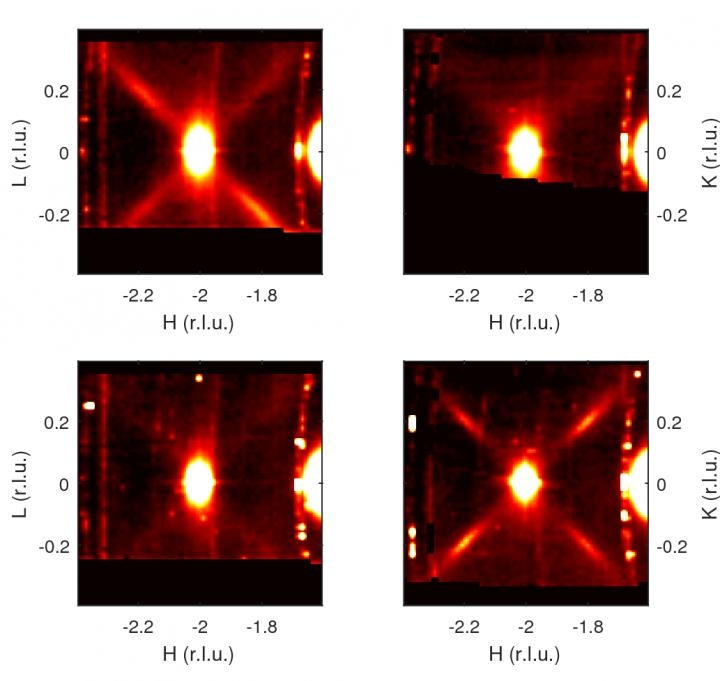Feb 1 2017
 These are distributions of diffuse X-ray scattering in the new phase of PbZrO3. Upper and lower rows correspond to different domain states. Credit: Press photo
These are distributions of diffuse X-ray scattering in the new phase of PbZrO3. Upper and lower rows correspond to different domain states. Credit: Press photo
Researchers from Peter the Great Saint-Petersburg Polytechnic University (SPbPU) together with Swiss, Polish and French researchers have discovered unique atomic-scale techniques in the crystal lattice of antiferroelectric lead zirconate during synchrotron X-ray scattering experiment. This finding is the first step toward developing efficient electrolyte-free accumulators of electric energy.
The article titled “Critical scattering and incommensurate phase transition in antiferroelectric PbZrO3 under pressure” was published in the Nature Group’s Scientific Reports.
During the experiment, the researchers tried to better understand the microscopic physics of antiferroelectric materials, which are very difficult to explain theoretically. This group’s model object is lead zirconate.
Having studied this crystal’s properties, which are representative among lead-based antiferroelectrics, researchers can use the obtained microscopic picture to explain the properties of a sufficiently wide range of materials. It is essential to understand the physics of these materials in order to create new functional materials aimed at specific applications.
Under the external influence, the crystal may have two kinds of lattice dipole ordering, where the dipoles are placed either parallel or antiparallel to each other. The material’s functional properties depend on the kind of lattice order.
In order to examine the functional properties of the material, it is necessary to understand how the material structure responds to the external parameters changing, such as field, pressure, and temperature. During the experiment, the research team analyzed the impact of simultaneous change of pressure and temperature to the material properties. The measurements were carried out at the European Synchrotron Radiation Facility (ESRF).
The synchrotron X-ray source is required to provide the photon flux, which is strong enough for diffuse scattering as well as ordinary Bragg scattering. The diffuse scattering has become the key to discover innovative properties in the crystal lattice. Researchers have defined that the symmetry of the crystal phases, which exists at high temperatures and pressures, is not the same as it was assumed long time ago.
The experiment was carried out in conditions similar to those that can be produced in future energy storage device (accumulators), where energy storage and release occur as a result of switching between the crystal phases of different structures.
This structural switching will play a role in the release of significant energy in a very short period of time, and lack of electrolytes has clear advantages in terms of miniaturization and integration of energy storage elements.
In the study, the researchers were able to discover the structure of the incommensurate phase, the phenomenon rarely happening in crystal structures. Theoretically, this objet is quite difficult to explain. Researchers of SPbPU and collaborators discovered that lead zirconate is the functional material, where the incommensurate phases could be located.
Based on the macroscopic measurements, researchers have suspected that the existing theories describing the crystal lattice are not fully correct. The contradictions arise on considering the evolution of the system in pressure-temperature space, and therefore we wanted to find out what processes occur on micro levels. Thus, during the experiment, we identified the incommensurate phase in substitution-free antiferroelectric for the first time.
Dr. Roman Burkovsky, Associate Professor, SPbPU
Now, the scientific community has the task of creating the theoretical models to reliably describe energy states, and their reaction to external influence. "We have proved that such conditions exist in the in model antiferroelectric, thus highlighting the new challenge to the scientific community. By solving this problem, a big step in the description of functional materials will be taken," added Dr. Roman Burkovsky.